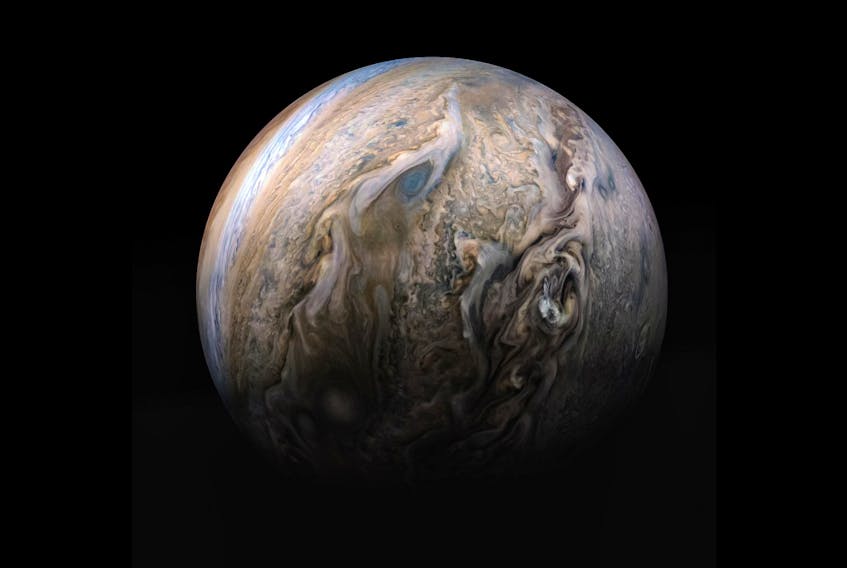With last week's planet, Mars, we leave the rocky, terrestrial planets behind, and venture into the realm of the gas giants - Jupiter and Saturn.

Largest of our solar system planets, mighty Jupiter reigns supreme; it has two-and-a-half times the combined mass of all the other planets, moons, asteroids, meteoroids and comets in the solar system.
The fifth planet from the sun, and one of the five "bright" planets known to the ancients, Jupiter orbits at an average distance of approximately 778 million kilometres (5.2 AU) once every 11.86 Earth years; has an equatorial diameter of 142,984 kms (11.21 times Earth's equatorial diameter); and a mass about 318 times that of Earth.
Its extremely dense atmosphere is composed primarily of hydrogen (86.2 per cent), and helium (13.6 per cent), with the remainder made up of trace amounts of methane, ammonia, water vapor and other gases. Due to its dense, opaque atmosphere, nothing can be seen of the planet's core, which is believed to be rocky. It is thought that the core (estimated at approximately 11,000 kms in diametre) constitutes only 2.6 per cent of the planet's mass, and is surrounded by an ocean of liquid, metallic hydrogen, overlaid by an outer layer of molecular hydrogen extending up to the cloud tops.
Like Saturn, Jupiter has rings (first discovered by the Voyager 1 flyby in 1979), though, because they are composed primarily of dust particles, they are dark, and cannot be seen except by flyby or orbiting spacecraft, or through Earth's largest telescopes. Jupiter has 79 known moons (until recently the planet with the most), the largest of which are the four Galilean moons (discovered by Galileo in 1610) - Io, Europa, Callisto and Ganymede.
The planet itself was named after the Roman ruling monarch of Olympus, the mythological realm of the gods. To the ancient Babylonians, it represented Marduk, the bull calf son of their sun god, Utu. In ancient Asian cultures, it was called the wood star, after one of the five elements. In Germanic mythology, Jupiter was synonymous with Thor, god of thunder, lightning and storms. To the ancient Greeks, it was Phaethon "the shining one", eventually becoming Zeus, their omnipotent ruler of the heavens.
It is from the Greeks that the names of the four Galilean moons originate. In Greek mythology, Zeus was a notorious seducer of mortal women, often taking the form of various animals or other people to lure the unsuspecting lady to a secluded rendezvous. Europa, a Phoenician noblewoman, was abducted by Zeus (in the form of a white bull) and carried off to Crete, where she gave birth to Minos (later king of Crete); the name of the continent of Europe is derived from her name. Callisto was another mortal maiden who caught Zeus's roving eye; when Hera (Zeus's vengeful wife) discovered their tryst, she changed Callisto into a great bear, and her son, Arcas (child of her union with Zeus) into a smaller bear, both of whom were later placed in the heavens by Zeus as the Great Bear and the Little Bear (the constellations of Ursa Major and Ursa Minor, respectively).

Io, subject of yet another of Zeus's earthly flings, was transformed by Zeus into a white heifer to hide her from the attention of his wife, Hera (some versions of the myth have Hera, in a rage, turning Io into the heifer when she discovered their liaison); she became the ancestor to the famous Greek heroes, Perseus and Hercules. Ganymede, a handsome young prince of Troy, was abducted by Zeus in the form of any eagle, and carried off to Mount Olympus to serve as the royal cup-bearer at his feasts.
Due to Jupiter's rapid rotation (once every 11 hours, fastest of all the planets), its upper cloud layers are separated into numerous bands of various colours and patterns circling around the planet at different latitudes. Some of these bands contain swirling vortices, what astronomers classify as "storms", the most famous being the Great Red Spot, a storm system which, though it has varied somewhat in size over the years, has been in existence since at least 1664 (and probably many centuries, if not millennia, before), when it was first viewed in a telescope.
Though there have been numerous flybys by robotic spacecraft, over the years - Pioneer 10 in 1973; Pioneer 11 in 1974; Voyagers 1 and 2 in 1979; Galileo in 1995; Cassini in 2000; New Horizon in 2007; and the latest, Juno, which entered Jovian orbit July 4, 2016 - probes that were sent into the Jovian atmosphere didn't survive more than a couple of hours, and never reached the planet's surface due to the hurricane force winds in the upper atmosphere, high temperatures (2,000K), and extreme atmospheric pressures they experienced.
Future planned missions to Jupiter - ESA's Jupiter Icy Moon Explorer in 2022, and NASA's Europa Clipper in 2023 - will study, in greater detail, the moons Callisto, Ganymede and Europa, as these ice-covered satellites show indications of having oceans of liquid water (thus the potential for life) beneath their frozen surfaces. Jupiter's massive size and location relative to the sun had a profound impact on the formation of the early solar system. Its gravitational interaction with the other planets help shaped the solar system's ordering of the planets. Most of the planets (except Mercury) actually lie closer to the orbital plane of Jupiter than they do the sun's.
Jupiter and Saturn both continue, as they have since the summer, to be visible in the southwest at dusk. Jupiter disappears from view by about 8:30 p.m., followed by Saturn around 10:30 p.m. Venus and Mars are poised to reappear in our dawn skies in the early part of November, with Mercury, once it completes its transit of the sun on Nov. 11, forecast to make one of its best early morning apparitions of the year in the following weeks.
Comet c/2019 Q4 Borisov (mag. +16) sits just below Regulus (the bright star that forms the "period" to the reverse question mark shape of the lion's head in the constellation of Leo - the Lion) visible in the eastern, pre-dawn sky. Another comet, Comet PANSTARRS (C/2017 T2), is currently passing through the constellation of Auriga - the Charioteer, visible in the NE night sky by about 10 p.m. Though still well below naked-eye visibility (currently at 12.45 magnitude), it is expected to continue to brighten in the coming months as it draws closer to the sun, possibly becoming a naked-eye object by the time it achieves perihelion (closest approach to sun) next May. Go online to follow developments of both these comets.
Until next time, clear skies. Next week - Saturn - Lord of the Rings.
Glenn K. Roberts lives in Stratford, P.E.I., and has been an avid amateur astronomer since he was a small child. He welcomes comments from readers, and anyone who would like to do so is encouraged to email him at [email protected].
Events:
Oct. 28 - New Moon
Nov. 2 - Moon below Saturn









